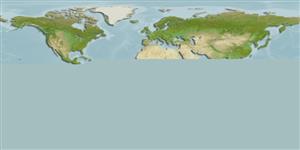Environment: milieu / climate zone / depth range / distribution range
Écologie
marin récifal; profondeur 0 - 50 m (Ref. 189). Tropical; 2°S - 20°S, 174°E - 171°W (Ref. 189)
Central Pacific: Fiji and Samoa.
Taille / Poids / Âge
Maturity: Lm ? range ? - ? cm
Max length : 7.5 cm SL mâle / non sexé; (Ref. 128118)
This species is distinguished by the following characters: gill rakers on first gill arch, upper series 20-24 (modally 21), lower series 27-30 (29), total 48-53 (50); gill rakers on second gill arch upper series 14-17 (15), lower series 25-30 (26), total 40-47 (41); gill rakers on third gill arch, upper series 11-13 (12), lower series 13-16 (15), total 24-29 (26); gill rakers on fourth gill arch, upper series 8-10 (8), lower series 10-13 (12), total 19-22 (20); prepelvic scutes 2-5 (4); upper jaw long, its posterior tip slightly short of or just reaching to posterior border of preopercle; predorsal scutes absent; pelvic scute no spine; posterior border of preopercle convex, rounded; parietal and occipital regions with obscure paired dark patches, without following dark lines; no black spots below eye and lower-jaw tip; body relatively elongate, its depth 17.0-20.0% of SL (mean 18.7%); anal-fn base long, its length 20.2-23.3% of SL (21.2%); caudal peduncle relatively short, its length 14.4-18.3% of SL (16.4%); posterior tip of pelvic fin reaching to the second–fifth dorsal-fin ray origin (Ref. 128118).
A schooling species in shallow coastal waters. Used as bait in the tuna fishery in the South Pacific, although rare in bait catches in Fiji and Samoa.
Life cycle and mating behavior
Maturité | Reproduction | Frai | Œufs | Fécondité | Larves
Hata, H. and H. Motomura, 2018. Stolephorus insignus, a new anchovy from the western Pacifc, and redescription of Stolephorus apiensis (Jordan and Seale 1906) (Clupeiformes: Engraulidae). Ichthyol. Res.1-9. (Ref. 128118)
Statut dans la liste rouge de l'IUCN (Ref. 130435)
Menace pour l'homme
Harmless
Utilisations par l'homme
Pêcheries: pêcheries vivrières; appât: usually
Plus d'informations
Noms communsSynonymesMétabolismePrédateursÉcotoxicologieReproductionMaturitéFraiRassemblement de ponteFéconditéŒufsDéveloppement de l'œuf
RéférencesAquacultureProfil d'aquacultureSouchesGénétiqueElectrophoresesHéritabilitéPathologiesTraitementNutrientsMass conversion
CollaborateursImagesStamps, Coins Misc.SonsCiguateraVitesseType de nageSurface branchialeOtolithesCerveauxVision
Outils
Articles particuliers
Télécharger en XML
Sources Internet
Estimates based on models
Preferred temperature (Ref.
123201): 27 - 27.7, mean 27.2 °C (based on 8 cells).
Phylogenetic diversity index (Ref.
82804): PD
50 = 0.5000 [Uniqueness, from 0.5 = low to 2.0 = high].
Bayesian length-weight: a=0.00562 (0.00259 - 0.01222), b=3.18 (3.00 - 3.36), in cm total length, based on LWR estimates for this (Sub)family-body shape (Ref.
93245).
Niveau trophique (Ref.
69278): 3.3 ±0.4 se; based on size and trophs of closest relatives
Résilience (Ref.
120179): Haut, temps minimum de doublement de population inférieur à 15 mois (Preliminary K or Fecundity.).
Fishing Vulnerability (Ref.
59153): Low vulnerability (10 of 100).
